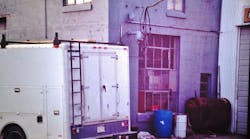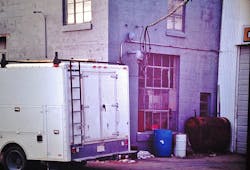How well do you know the Code? Think you can spot violations the original installer either ignored or couldn't identify? Here's your chance to moonlight as an electrical inspector and second-guess someone else's work from the safety of your living room or office. It's your turn to identify the violation.
Hint: Look out below!
Find the Answer
Oh boy! Sparks could fly like it was the 4th of July if that truck parked a little closer to the building. It could have easily made contact with the overhead service conductors, which are installed way too low. The bottom of the drip loop is probably only 7 ft above the ground.
Section 230.24(B)(1) requires a minimum clearance of at least 10 ft from grade to the lowest point of the drip loop. In streets, alleys, roads, and parking areas subject to truck traffic, Sec. 230.24(B)(4) requires a clearance of at least 18 ft. This area is obviously subjected to truck traffic.
There seems to be plenty of room on the side of the building for the installer to have run the pipe to a higher spot on the exterior wall in order to get the required clearances from grade, but, for some reason, he decided to take this shortcut. This shortcut now leaves these wires in danger of being ripped off the building by a passing vehicle.
Imagine what could have happened if the ladder racks on this truck got caught on the service wires when the truck’s driver decided to drive away. Kaboom!





